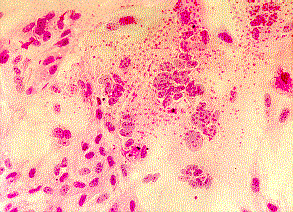
Laboratory Diagnosis of Mumps Infection
E. Laboratory Diagnosis
During mumps infection, several non-specific findings may be present in the blood. The WBC may be low with lymphocytes predominating. ESR and CRP may be normal or slightly elevated. Amylase levels may be elevated.
1. Serology ;- a serological diagnosis is usually made by finding a significant increase in Ab titres in 2 serum samples taken 10 - 14 days apart. In some cases, the detection of IgM may be used to diagnosis acute infection. Although only 1 serotype of mumps exist, cross-reactions between mumps virus and paramyxovirus makes serological results difficult to interpret on occasions. Several techniques are available :
2. Virus Isolation ;- virus isolation may be carried out by allantoic inoculation of 6 day old embryonated eggs or by tissue culture methods. Virus can be isolated from the CSF during the first 2 - 3 days after the onset of disease, and is present in urine and saliva for 2 to 3 weeks. Monkey kidney cells are generally used for virus isolation where a CPE is seen which consists of the formation of syncytia and the focal rounding of cells. Virus identification can be performed by neutralization or inhibition of haemadsorption by specific sera.
Syncytial formation caused by mumps virus. Note the presence of red blood cells on the surface of the cell sheet (haemadsorption). Courtesy of Linda Stannard, University of Cape Town, S.A.
F. Management and Prevention
No specific treatment is available for mumps. Uncomplicated parotitis seldom require treatment except adequate. Some authorities recommend a short course of corticosteriods in severe cases. Mumps is the commonest cause of meningitis and encephalitis in many countries such as USA and Scandinavia and many countries have mumps vaccination as part of their vaccination program. At one time, there was some argument as to whether a vaccination program against mumps was necessary but the combination of mumps with rubella and measles in the same vaccine had swung the argument vastly in its favour. An inactivated vaccine was first used in the 1940s successfully. This has now been replaced by a live attenuated vaccine. The protection rate is over 95% and no adverse reactions are associated with the vaccine. In the USA, where more than 40 million doses of mumps vaccine have been administered, a cost-benefit analysis has been carried out. In a cohort of 1 million people, the vaccine would prevent over 74,000 cases of mumps and 3 deaths and the cost-benefit ratio is 7.4:1. Mumps vaccine is now routinely given as part of the MMR regimen in many countries to all infants.